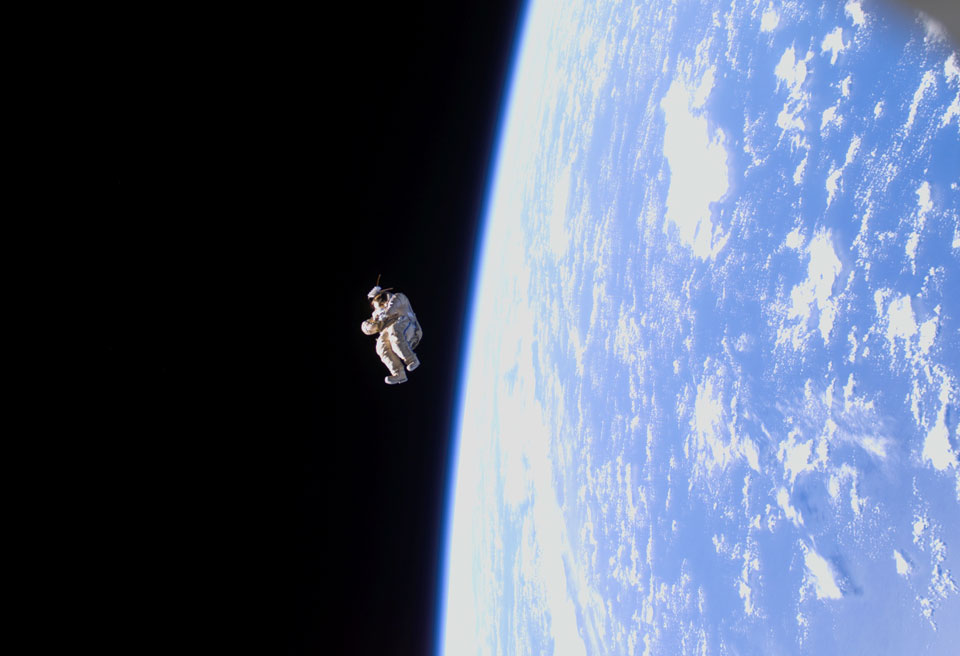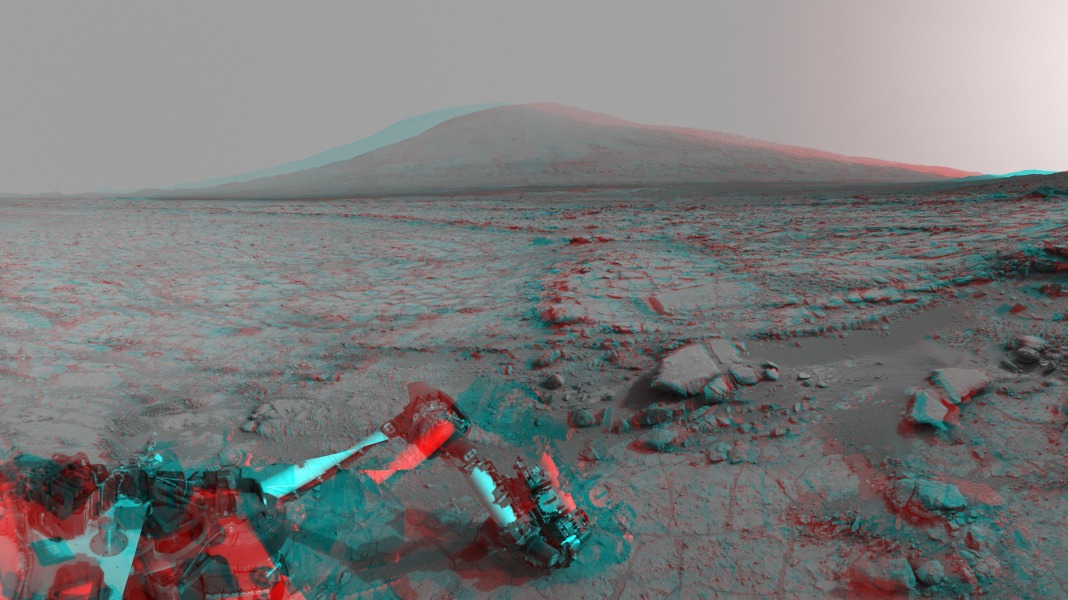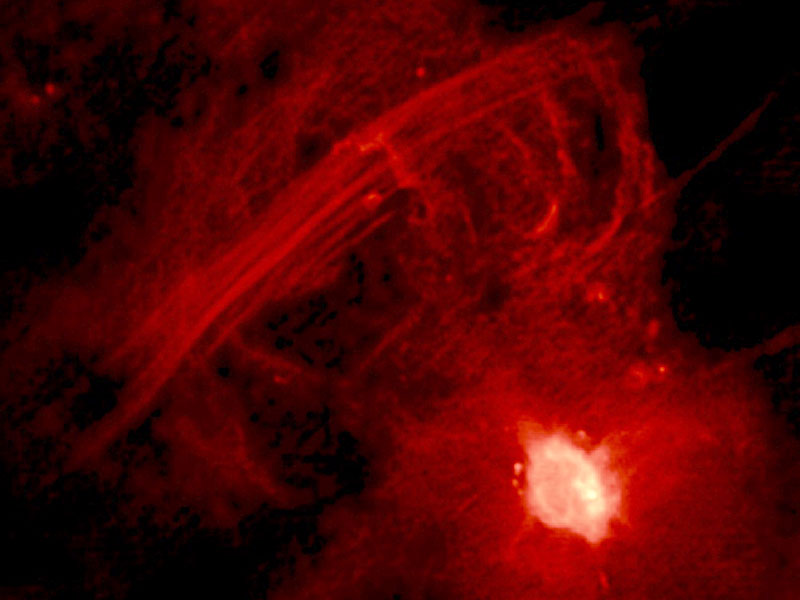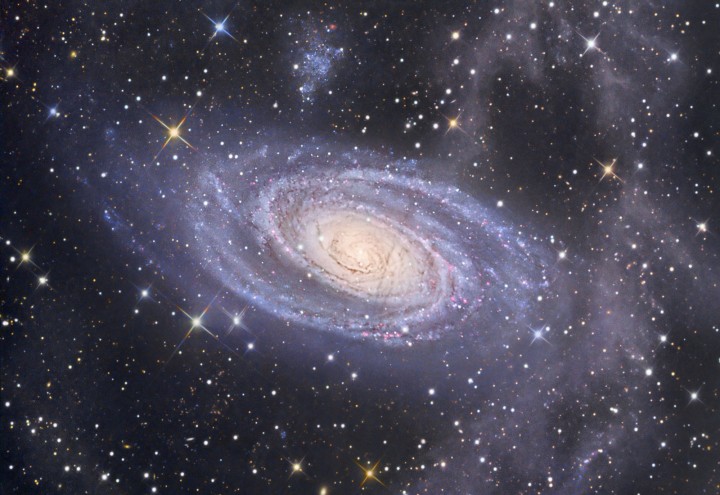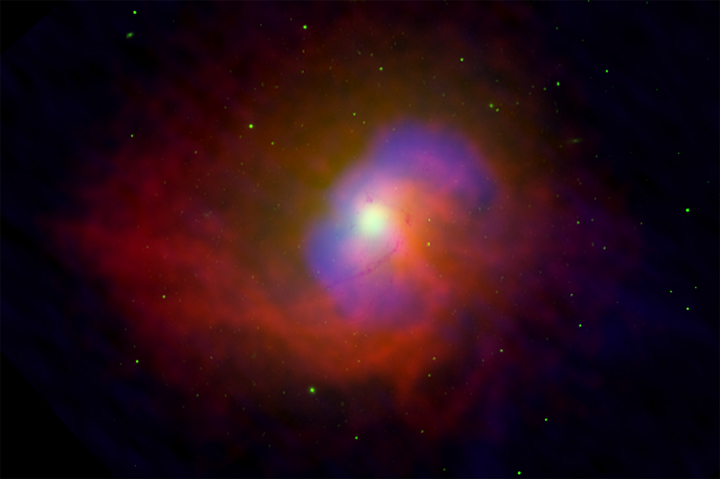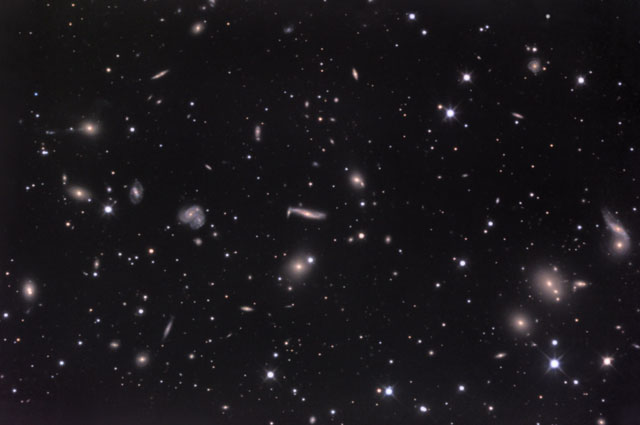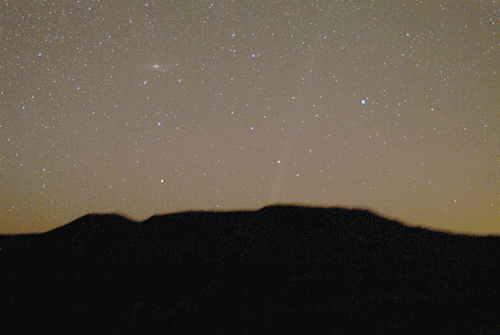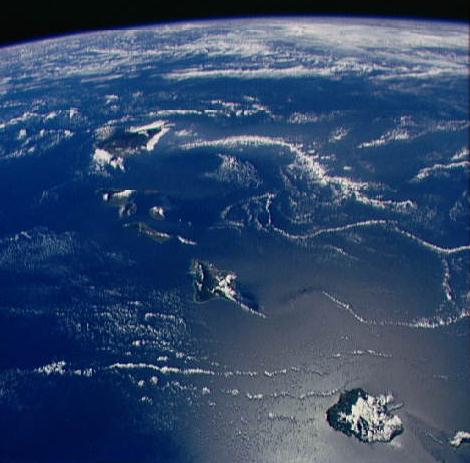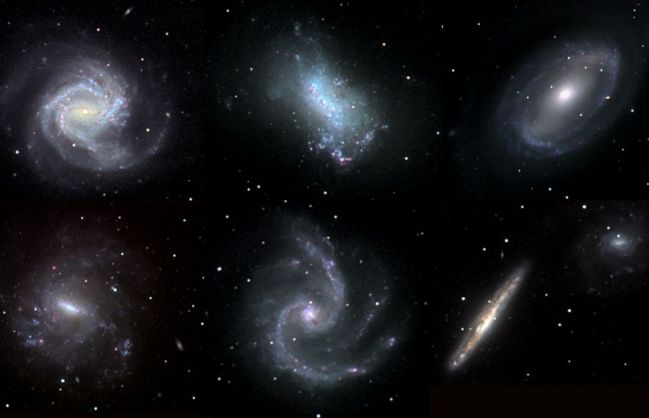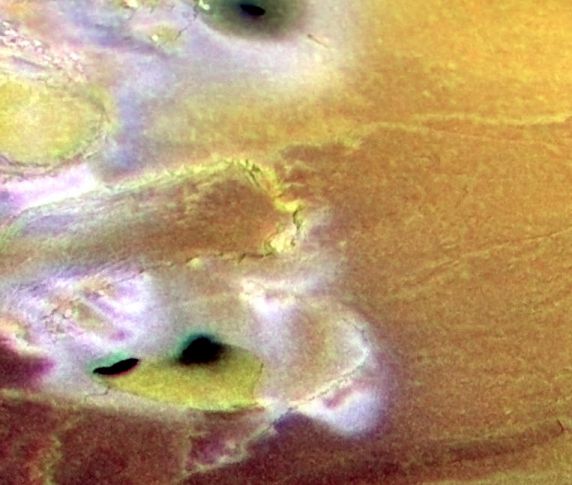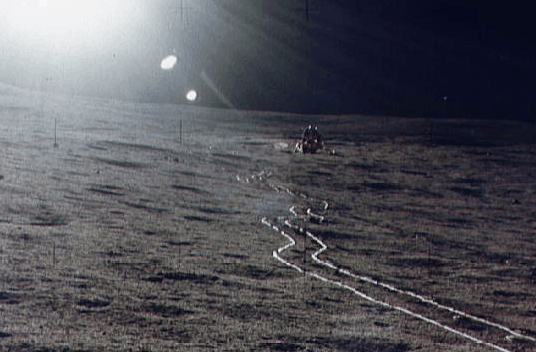| << Previous | Index | Next >> |
2015 What's that in front of the Moon? It's the International Space Station. Using precise timing, the Earth-orbiting space platform was photographed in front of a partially lit Moon last year. The featured image was taken from Madrid, Spain with an exposure time of only 1/1000 of a second. In contrast, the duration of the transit of the ISS across the entire Moon was about half a second. The sun-glinting station can be seen just to the dark side of the day / night line known as the terminator. Numerous circular craters are visible on the distant Moon, as well as comparatively rough, light colored terrain known as highlands, and relatively smooth, dark colored areas known as maria. On-line tools can tell you when the International Space Station will be visible from your area.
2014 A spacesuit floated away from the International Space Station eight years ago, but no investigation was conducted. Everyone knew that it was pushed by the space station crew. Dubbed Suitsat-1, the unneeded Russian Orlan spacesuit filled mostly with old clothes was fitted with a faint radio transmitter and released to orbit the Earth. The suit circled the Earth twice before its radio signal became unexpectedly weak. Suitsat-1 continued to orbit every 90 minutes until it burned up in the Earth's atmosphere after a few weeks. Pictured above, the lifeless spacesuit was photographed in 2006 just as it drifted away from space station.
2013 Get out your red/blue glasses and gaze across the floor of Gale crater on Mars. From your vantage point on the deck of the Curiosity Rover Mount Sharp, the crater's 5 kilometer high central mountain looms over the southern horizon. Poised in the foreground is the rover's robotic arm with tool turret extended toward the flat veined patch of martian surface dubbed "John Klein". A complete version of the stereo view spans 360 degrees, digitally stitched together from the rover's left and right navigation camera frames taken in late January. The layered lower slopes of Mount Sharp, formally known as Aeolis Mons, are a future destination for Curiosity.
2012 Planet Earth has many moons. Its largest artifical moon, the International Space Station, streaks through this lovely skyview with clouds in silhouette against the fading light of a sunset. Captured from Stuttgart, Germany last Sunday, the frame also includes Earth's largest natural satellite 1.5 days after its New Moon phase. Just below and left of the young crescent is Jupiter, another bright celestial beacon hovering near the western horizon in early evening skies. Only briefly, as seen from the photographer's location, Jupiter and these moons of Earth formed the remarkably close triple conjunction. Of course, Jupiter has many moons too. In fact, close inspection of the photo will reveal tiny pin pricks of light near the bright planet, large natural satellites of Jupiter known as Galilean moons.
2011 In silhouette against a crowded star field toward the constellation Scorpius, this dusty cosmic cloud evokes for some the image of an ominous dark tower. In fact, clumps of dust and molecular gas collapsing to form stars may well lurk within the dark nebula, a structure that spans almost 40 light-years across this gorgeous telescopic portrait. Known as a cometary globule, the swept-back cloud, extending from the lower right to the head (top of the tower) left and above center, is shaped by intense ultraviolet radiation from the OB association of very hot stars in NGC 6231, off the upper edge of the scene. That energetic ultraviolet light also powers the globule's bordering reddish glow of hydrogen gas. Hot stars embedded in the dust can be seen as bluish reflection nebulae. This dark tower, NGC 6231, and associated nebulae are about 5,000 light-years away.
2010 What created this strange sound in Earth's Pacific Ocean? Pictured above is a visual representation of a loud and unusual sound, dubbed a Bloop, captured by deep sea microphones in 1997. In the above graph, time is shown on the horizontal axis, deep pitch is shown on the vertical axis, and brightness designates loudness. Although Bloops are some of the loudest sounds of any type ever recorded in Earth's oceans, their origin remains unknown. The Bloop sound was placed as occurring several times off the southern coast of South America and was audible 5,000 kilometers away. Although the sound has similarities to those vocalized by living organisms, not even a blue whale is large enough to croon this loud. The sounds point to the intriguing hypothesis that even larger life forms lurk in the unexplored darkness of Earth's deep oceans. A less imagination-inspiring possibility, however, is that the sounds resulted from some sort of iceberg calving. No further Bloops have been heard since 1997, although other loud and unexplained sounds have been recorded.
2009 What's causing those strange dark streaks in the rings of Saturn? Prometheus. Specifically, an orbital dance involving Saturn's moon Prometheus keeps creating unusual light and dark streamers in the F-Ring of Saturn. Now Prometheus orbits Saturn just inside the thin F-ring, but ventures into its inner edge about every 15 hours. Prometheus' gravity then pulls the closest ring particles toward the 100-km moon. The result is not only a stream of bright ring particles but also a dark ribbon where ring particles used to be. Since Prometheus orbits faster than the ring particles, the icy moon pulls out a new streamer every pass. Sometimes, several streamers or kinks are visible at once. The above photograph taken in mid-January by the robotic Cassini Spacecraft orbiting Saturn. The oblong moon Prometheus is visible on the far left of the image.
2008 What causes this unusual structure near the center of our Galaxy? The long parallel rays slanting across the top of the above radio image are known collectively as the Galactic Center Radio Arc and jut straight out from the Galactic plane. The Radio Arc is connected to the Galactic center by strange curving filaments known as the Arches. The bright radio structure at the bottom right likely surrounds a black hole at the Galactic center and is known as Sagittarius A*. One origin hypothesis holds that the Radio Arc and the Arches have their geometry because they contain hot plasma flowing along lines of constant magnetic field. Images from the Chandra X-ray Observatory appear to show this plasma colliding with a nearby cloud of cold gas.
2007 One of the brightest galaxies in planet Earth's sky and similar in size to the Milky Way, big, beautiful spiral M81 lies 11.8 million light-years away in the northern constellation Ursa Major. This remarkably deep image of the region reveals details in the bright yellow core, but at the same time follows fainter features along the galaxy's gorgeous blue spiral arms and sweeping dust lanes. Above M81 lies a dwarf companion galaxy, Holmberg IX, sporting a large, pinkish star-forming region near the top. While M81 and Holmberg IX are seen through a foreground of stars in our own Milky Way galaxy, they are also seen here through a much fainter complex of dust clouds. The relatively unexplored clouds are likely only some hundreds of light-years distant and lie high above our galaxy's plane. Scattered through the image, especially at the the right, the dust clouds reflect the combined light of the Milky Way's stars and have been dubbed integrated flux nebulae.
2006
2005 These are galaxies of the Hercules Cluster, an archipelago of "island universes" a mere 650 million light-years distant. This cluster is loaded with gas and dust rich, star forming, spiral galaxies but has relatively few elliptical galaxies, which lack gas and dust and the associated newborn stars. Colors in the composite image show the star forming galaxies with a blue tint and ellipticals with a slightly yellowish cast. In this cosmic vista many galaxies seem to be colliding or merging while others seem distorted - clear evidence that cluster galaxies commonly interact. Over time, the galaxy interactions are likely to affect the the content of the cluster itself. Researchers believe that the Hercules Cluster is significantly similar to young galaxy clusters in the distant, early Universe and that exploring galaxy types and their interactions in nearby Hercules will help unravel the threads of galaxy andcluster evolution.
2004 Comet Bradfield has become quite a sight just before sunrise -- for those with binoculars or cameras. Although fading noticeably each day, a sky chart, a northern location, and some persistence will allow curious sky gazers to locate the cosmic snowball and its spectacular tail. One might call Bradfield a "camera" comet as its extended tail is too long for most telescopes but caught nicely by normal cameras capable of long exposures and set to rotate with the sky. Pictured above just yesterday, Comet C/2004 F4 (Bradfield) was caught as it rose on successive three-minute exposures above the Rocky Mountains near Yampa, Colorado, USA. Visible on the upper left as a bright fuzzy smudge is the Andromeda Galaxy (M31), far in the distance. Comet Bradfield was discovered only last month and was briefly visible to the unaided eye. It was imaged in spectacular fashion by the SOHO spacecraft as it rounded the Sun early last week.
2003 If you could look at Venus with radar eyes - this is what you might see. This computer reconstruction of the surface of Venus was created from data from the Magellan spacecraft. Magellan orbited Venus and used radar to map our neighboring planet's surface between 1990 and 1994. Magellan found many interesting surface features, including the large circular domes, typically 25-kilometers across, that are depicted above. Volcanism is thought to have created the domes, although the precise mechanism remains unknown. Venus' surface is so hot and hostile that no surface probe has lasted more than a few minutes.
2002 Aloha! With the graceful arc of Earth's limb in the background, the Hawaiian Island archipelago is visible in this stunning photo taken by the astronauts onboard the shuttle Discovery in October of 1988. Along with popular beaches and tropical resorts, these volcanic islands offer extreme elevations with dark, dry, cloudless skies. Consequently they have also become popular sites for large and sophisticated ground based telescopes. The peak of Mauna Kea, on the Big Island (upper left), boasts an impressive array of astronomical instruments including twin Kecks, the Canada-France-Hawaii Telescope, the NASA IRTF, the JCMT and UKIRT, the Subaru and the Gemini Telescope Project. The dormant volcanic cone of Haleakala on Maui (just below the Big Island) is home to the Air Force Maui Optical Station and the Mees Solar Observatory. Mahalo nui loa!
2001 A tantalizing assortment of island universes is assembled here. From top left to bottom right are the lovely but distant galaxies M61, NGC 4449, NGC 4725, NGC 5068, NGC 5247, and NGC 5775/5774. Most are spiral galaxies more or less like our own Milky Way. The color images reveal distinct pink patches marking the glowing hydrogen gas clouds in star forming regions along the graceful spiral arms. While Virgo cluster galaxy M61 is perhaps the most striking of these spirals, the interesting galaxy pair NGC 5775/5774 neatly contrasts the characteristic spiral edge-on and face-on appearance. The one exception to this parade of photogenic spiral galaxies is the small and relatively close irregular galaxy NGC 4449 (top middle). Similar to the Large Magellanic Cloud, companion galaxy to the Milky Way, NGC 4449 also sports young blue star clusters and pink star forming regions. All the galaxies in this gallery were imaged with a small (16 inch diameter) reflecting telescope and digital camera by public participants in the Kitt Peak National Observatory Visitor Center's Advanced Observing Program.
2000 Braving intense radiation belts, the Galileo spacecraft once again flew past the surface of Jupiter's moon Io (sounds like EYE-oh) on February 22. Combining high resolution black and white images from that flyby with color data recorded last summer has resulted in this dramatic view of a region near the volcanic moon's south pole. An active and alien landscape, the bright white areas are likely due to sulfur dioxide frost and seem to be concentrated near ridges and cliffs. The three ominous black spots, each about 6-12 miles across, are volcanic craters or calderas covered with recent dark lava. A sinuous channel connects the lower left caldera with a yellowish lava flow. Io is small, but its continuous activity is driven by the drastic tides induced by Jupiter and the other Jovian moons. It is estimated that the resulting volcanism completely resurfaces Io every million years.
1999 Another large snowball is falling toward the Sun. Comet Lee was discovered two weeks ago by Steve Lee (AAO) in Australia, and is expected to brighten as it approaches the inner Solar System. Comet Lee is not expected to become a naked-eye object, though, with recent projections guessing it will peak at magnitude 7 in July. Starting in May, the large piece of dirty ice officially known as Comet C/1999 H1 Lee will be visible to northern observers. Comet Lee is the fuzzy patch in the above picture taken on April 16 from Loomberah, Australia.
1998 How can a round star make a square nebula? This conundrum came to light with the discovery of planetary nebulae like IC 4406. IC 4406 is most probably cylindrical, with its square appearance the result of our vantage point in viewing the cylinder. Hot gas is known to be flowing out the ends of the cylinder, while filaments of dark dust and molecular gas lace the bounding walls. The star primarily responsible for this interstellar sculpture can be found in the nebula's center. In a few million years, the only thing left visible in IC 4406 will be a fading white dwarf star.
1997 Sputnik means "traveling companion". Despite the innocuous sounding name, the launch of the Earth's first "artificial moon", Sputnik 1, by the Soviets on October 4, 1957 shocked the free world, setting in motion events which resulted in the creation of NASA and the race to the Moon. Sputnik 1 was a 184 pound, 22 inch diameter sphere with four whip antennas connected to battery powered transmitters. The transmitters broadcast a continuous "beeping" signal to an astounded earthbound audience for 23 days. A short month later, on November 3, the Soviets followed this success by launching a dog into orbit aboard Sputnik 2.
1996 Brilliant sunlight glints off tracks gently winding across the the Moon's Frau Maro highlands. The tracks were made by the Apollo 14 crew's two-wheeled Modularized Equipment Transporter (MET), fondly known as the "rickshaw". The MET was designed as an aid to surface exploration. Serving as a workbench with a place for the lunar handtools, it also carried cameras, sample containers, spare film and a Lunar Surface Penetrometer. The path outlined in the lunar soil leads away from Alan Shepard and Edgar Mitchell's Lunar landing Module, tracing the path of their first venture across the lunar landscape.
| << Previous | Index | Next >> |

